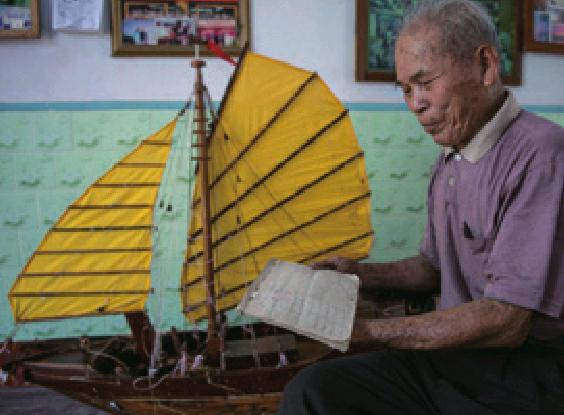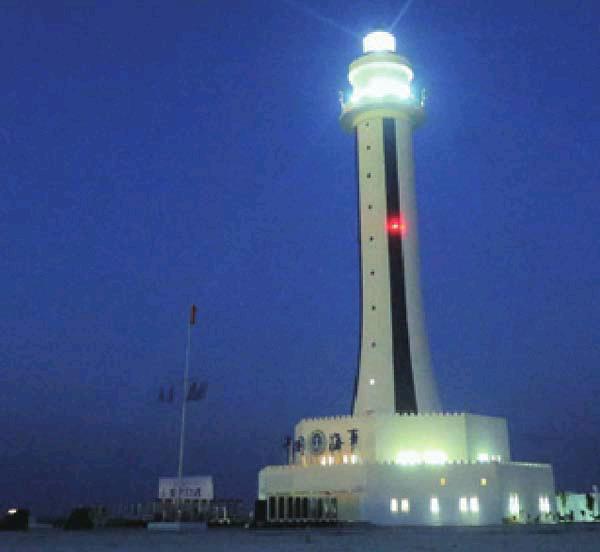A WAY THROUGH THE SOUTH CHINA SEA
2016-08-08ByYuLintao
By+Yu+Lintao
Geng Lu Bu (Manual of Sea Routes), handed down since the Yuan Dynasty (1271-1368), was one of the major guides used by Zheng Qingzhis great grandfather to sail on the South China Sea. Zheng is vice mayor of Qionghai City in south Chinas Hainan Province, and his great grandfather was captain of a fishing vessel during the Qing Dynasty (1644-1911).
“For many generations, my ancestors lived on fishing. With Geng Lu Bu, they reached the Nansha, Xisha and Huangyan islands,” Zheng told reporters.
Historically, such fishing trips could last up to half a year, landing on islands like Taiping, Zhongye and Ganquan, where fresh water was available. Wells dug by long-forgotten Chinese fishermen can still be found today.
Some fishing families still retain handwritten copies of Geng Lu Bu, yellowed with age, even though traditional fishing methods have long been supplanted by modern practices.
The traditional life of Chinese fishermen in the region is now under greater threat following the announcement of an award by an ad hoc arbitral tribunal in a case concerning the South China Sea unilaterally initiated by the Philippines, the outcome of which is likely to infringe upon the rights of Chinese fishermen whose families have lived in the region for generations. Many such fishermen find the award unbelievable and wonder why the waters fished for centuries by them and their ancestors have become the“exclusive economic zone” of another country.
Untenable verdict
China has declared that the award is null and void and has no binding force.
Lou Chunhao, a researcher on maritime issues with the China Institutes of Contemporary International Relations (CICIR), noted that the arbitration process is full of legal loopholes. The tribunal failed to take into account historical relics on the islands, and its objectivity is questionable.
According to Hou Yi, a researcher with the Institute of China Borderland Studies under the Chinese Academy of Social Sciences, books published in the 19th and 20th centuries by Japanese, British and U.S. scholars mentioned the work of Chinese fishermen on South China Sea Islands, the wells they dug and the coconut trees they planted. Chinese tombs and temples were also seen on the islands.
The South China Sea Islands—including the Dongsha Islands, the Xisha Islands, the Zhongsha Islands and the Nansha Islands—constitute inseparable parts of Chinas territory.
China has held sovereign jurisdiction over the waters islands and reefs for 2,000 years as evidenced by ancestral properties that have been passed down for generations.
According to the Chinese Governments recently published white paper titled China Adheres to the Position of Settling Through Negotiation the Relevant Disputes Between China and the Philippines in the South China Sea, China was the first country to discover, name, explore and exploit the South China Sea Islands and the first to continuously exercise sovereign jurisdiction over them. Maps of the South China Sea Islands were published throughout the Ming and Qing dynasties (1368-1911), including navigational charts drawn by Chinas 13th-century explorer Zheng He.
Chinas sovereignty over the South China Sea Islands had never been disputed before the 20th century. But in 1933, France invaded some islands and reefs of the Nansha Islands, creating the Incident of the Nine Islets. The then Chinese government defended its sovereignty over the Nansha Islands. The Committee for the Examination of Land and Sea Maps later compiled and published the Map of the South China Sea Islands of China in 1935.
Japan also invaded and illegally occupied some of the South China Sea islands during its war of aggression against China. As the worlds Anti-Fascist War unfolded, China, the United States and the United Kingdom demanded in the Cairo Declaration in December 1943 that all the territories Japan had stolen from the Chinese be restored to China. In July 1945, the three countries issued the Potsdam Proclamation, which explicitly declares in Article 8: “The terms of the Cairo Declaration shall be carried out.” In August 1945, Japan announced its unconditional surrender and its acceptance of the Potsdam Proclamation.
In November and December 1946, the then Chinese government dispatched senior military and civil officials to the Xisha Islands and the Nansha Islands to resume jurisdiction over these islands, with commemorative ceremonies held and sovereignty markers re-erected. In March 1947, China established the Nansha Islands Office of Administration on Taiping Island. In February 1948, the Map of the Administrative Districts of the Republic of China was published, including the 11-dash line which is represented as a nine-dash line in todays maps.
Since its founding on October 1, 1949, the Peoples Republic of China has upheld sovereignty over the South China Sea Islands and its relevant rights and interests in the region.
Chinas sovereignty over the South China Sea Islands and reefs has been acknowledged by a number of international sources throughout modern history, including, for example, British, German, French, and Soviet atlases of the area published in the 1950s and 1960s. Territorial claims by other South China Sea claimants, notably the Philippines, did not encompass marine features within the U-shaped nine-dash line area until the 1970s.
Another question is, how was it possible for the arbitration to be unilaterally initiated by the Philippines former Benigno Aquino IIIs administration? Arbitration takes place when disputing parties have agreed to settle their differences by arbitration. Law experts, therefore, have said that from the very beginning the tribunal should not have agreed to hear the dispute, since it was presented by one party alone.
Fu Kuncheng, a law professor with Xiamen University in east Chinas Fujian Province, has noted that contracting parties to the United Nations Convention on the Law of the Sea (UNCLOS) can exclude themselves by written statement from the applicability of any compulsory procedures, including arbitration, connected with disputes involving maritime delimitation, sovereignty, military conflict and historic rights, under Section 2 of Part XV of the convention. China issued a statement in 2006 in accordance with Article 298 of UNCLOS which said China would not accept compulsory procedures entailing binding decisions.
When interviewed by Xinhua News Agency, Tom Zwart, a professor of law at Utrecht University in the Netherlands, said, “The tribunal should not have accepted jurisdiction.” “From the outset, critics like me said that it would be very difficult to avoid sovereignty issues [when handling the Philippines claims],” Professor Zwart was quoted as saying.
The right path
Though the arbitral award was made heavily in favor of the Philippines, many have argued that the controversial decision cannot resolve any problems and will only heighten regional tensions.
Alberto A. Encomienda, a former Philippine diplomat, said, “Speaking as an international lawyer, I have some problem with the reasoning of the arbitration court. It is the first time Ive seen a judgment sweeping the whole win in favor of one party. That is my general impression.”
Graham Allison, Director of Harvards Belfer Center for Science and International Affairs, wrote in The Diplomat that China will of course ignore the ruling, as great powers have done historically.
In 2015, an arbitration award declared a marine conservation area set up by the UK violated UNCLOS, but London just ignored the decision. In its Nicaragua vs. the United States case in 1980, the International Court of Justice ordered the United States to compensate the Latin American country, but Washington simply refused.
In an interview with Xinhua, ASEAN Education Center Director Joseph Matthews said that from the beginning, the arbitral tribunal was under the sway of the United States and its ally Japan. “This is a one-sided verdict based on China-phobia,” he said, add- ing “It is very important for the United States to stop all kinds of interference and its suggestions regarding the regional conflicts.”
Matthews noted that “Manila should and must be mindful that any conflict in the region will jeopardize its economy and regional stability, and hence must not let outsiders guide or sway it on its foreign and internal policies.”
While rejecting the award, China also expressed its willingness to work directly with concerned countries to resolve the disputes in the South China Sea through negotiations. In a statement following the arbitration, the Chinese Foreign Ministry said negotiations and consultations should be carried out “on the basis of respecting historical facts and in accordance with international law.”
Lou, with the CICIR, said the South China Sea issue can be settled by bilateral talks, and shelving the disputes while seeking joint development is mutually beneficial.
In an interview with Beijing Review be- fore the arbitration award was issued, longtime observer of the South China Sea issue Bill Jones, Washington Bureau Chief of U.S. weekly Executive Intelligence Review, said the Philippines is better off working together with China to solve the issues rather than adhering to a policy that comes from the United States.
Professor Zwart told Xinhua he hopes that after perhaps a day of celebration in Manila, the Philippine side will come to its senses and contact Beijing to say, “We have to resolve this peacefully.”
Speaking prior to the award, the new Philippine President, Rodrigo Duterte, recently announced that Manila is ready to talk with Beijing even if the South China Sea arbitral tribunal ruled in favor of the Philippines. Hopefully, Duterte can soon put those words into action.
